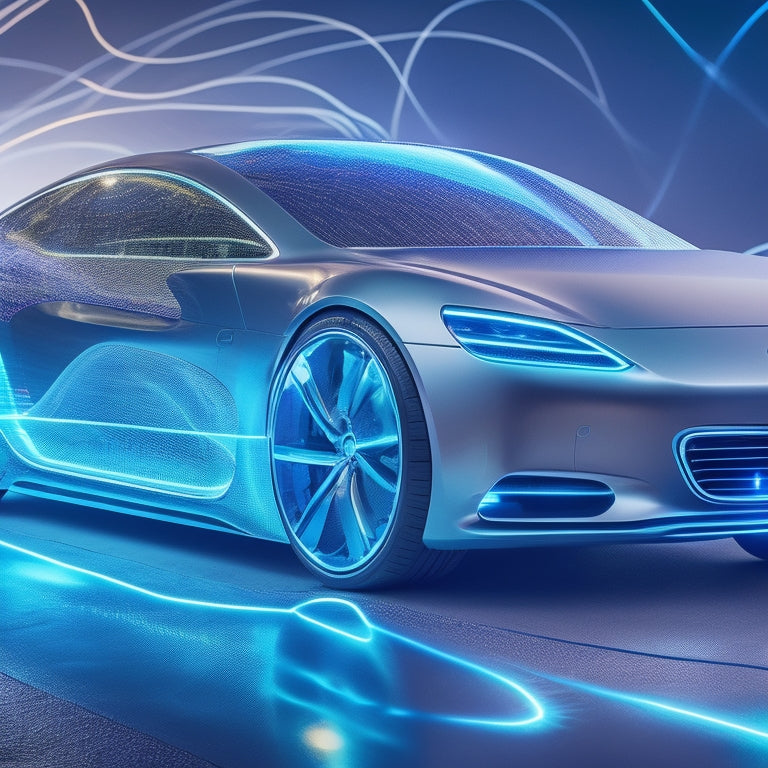
7 Best Next-Gen Car Battery Technologies Emerging
Share
As you explore the electric vehicle landscape, you'll discover that next-generation car battery technologies are rapidly advancing, with breakthroughs in lithium-ceramic batteries, solid-state batteries, and graphene-based energy storage, among others, poised to transform the industry. From enhanced safety features to improved energy density, these emerging technologies are redefining the possibilities for sustainable transportation. You'll find innovations like advanced sodium-ion batteries, zinc-air battery innovations, and supercapacitor-battery fusion, all poised to drive electric vehicle adoption forward. As you dive deeper, you'll uncover the exciting possibilities that these cutting-edge battery technologies have in store.
Key Takeaways
• Lithium-ceramic batteries offer enhanced safety, improved energy density, and sustainable recycling, making them a promising next-gen technology.
• Solid-state batteries are poised to revolutionize the electric vehicle industry with improved thermal management, higher energy density, and enhanced safety features.
• Advanced sodium-ion batteries provide a cost-effective and environmentally friendly alternative to lithium-ion batteries, with comparable performance and scalability.
• Graphene-based energy storage solutions boast faster electron transfer, higher power density, and flexibility in battery design, making them an emerging technology to watch.
• Zinc-air batteries are being innovated with enhanced zinc recycling, advanced air filtration, and increased energy density, making them a promising next-gen technology for electric vehicles.
Lithium-Ceramic Battery Breakthroughs
Researchers have made notable progress in developing lithium-ceramic batteries, which boast enhanced safety features and improved energy density.
As you explore the latest advancements in lithium-ceramic battery technology, you'll discover that these innovations have far-reaching implications for the electric vehicle (EV) industry.
The introduction of ceramic coatings has greatly enhanced the safety of these batteries by reducing the risk of thermal runaway. This breakthrough has led to a substantial increase in energy density, making lithium-ceramic batteries an attractive option for EV manufacturers.
Additionally, the development of sustainable battery recycling processes has become a key focus area. You'll be interested to know that researchers are working on closed-loop recycling methods that can recover up to 95% of the materials used in lithium-ceramic batteries. This not only reduces waste but also decreases the environmental impact of battery production.
As the demand for EVs continues to grow, the advancements in lithium-ceramic battery technology are poised to play a critical role in shaping the future of sustainable transportation.
Solid-State Battery Revolution
As you explore the world of next-generation car battery technologies, you'll find that solid-state batteries are on the cusp of a revolution, poised to displace their lithium-ion counterparts with enhanced energy density, improved safety, and faster charging capabilities.
One of the key advantages of solid-state batteries lies in their improved thermal management. By replacing the liquid electrolyte with a solid material, solid-state batteries reduce the risk of thermal runaway, making them safer and more reliable.
| Feature | Solid-State Battery | Lithium-Ion Battery |
|---|---|---|
| Energy Density | 450 Wh/kg | 250 Wh/kg |
| Charging Speed | 10-20 minutes | 30-60 minutes |
| Safety | Reduced thermal runaway risk | Higher thermal runaway risk |
Solid-state batteries also boast a more efficient cell architecture, allowing for more efficient energy storage and release. This, combined with their improved thermal management, makes them an attractive option for next-generation electric vehicles.
With their enhanced performance and safety features, solid-state batteries are poised to revolutionize the electric vehicle industry, providing a more efficient, reliable, and sustainable solution for the future of transportation.
Advanced Sodium-Ion Batteries
By leveraging abundant sodium resources, advanced sodium-ion batteries are emerging as a cost-effective and sustainable alternative to traditional lithium-ion batteries, offering a promising solution for widespread electric vehicle adoption.
As you explore this technology, you'll find that it's not just about reducing production costs, but also about minimizing environmental impact.
Here are some key benefits of advanced sodium-ion batteries:
-
Cost effectiveness: Sodium is abundant and inexpensive, reducing production costs by up to 30% compared to lithium-ion batteries.
-
Environmental benefits: Sodium is extracted from seawater, eliminating the need for destructive mining practices and reducing waste.
-
Improved performance: Sodium-ion batteries have shown comparable energy density and cycle life to lithium-ion batteries.
-
Scalability: Sodium-ion batteries can be easily scaled up for mass production, making them an attractive option for widespread adoption.
-
Research advancements: Ongoing research is focused on improving sodium-ion battery performance, further increasing their viability as a sustainable alternative to traditional batteries.
Graphene-Based Energy Storage
As you explore graphene-based energy storage, you'll discover the unique properties of graphene's structure, which enables faster electron transfer and higher power density.
This leads to a significant boost in energy density, allowing for more efficient energy storage and release.
Graphene Structure Advantages
You'll benefit from graphene's unique structure, which allows for rapid electron transfer and high surface area, making it an ideal material for energy storage applications. This superior structure enables graphene to efficiently harness energy, allowing for more efficient energy storage and release.
Here are some key advantages of graphene's structure:
-
Flexibility: Graphene's flexibility allows it to be integrated into various battery designs, making it a versatile material for energy storage.
-
High surface area: Graphene's high surface area enables it to store more energy per unit of material, making it an efficient choice for energy storage.
-
Rapid electron transfer: Graphene's rapid electron transfer rate enables fast charging and discharging, making it suitable for high-performance energy storage applications.
-
Scalability: Graphene's scalable production process makes it a cost-effective material for large-scale energy storage applications.
-
Corrosion resistance: Graphene's resistance to corrosion promotes a longer lifespan for energy storage devices, reducing maintenance and replacement costs.
Energy Density Boost
Graphene-based energy storage solutions boast an impressive energy density boost, allowing them to pack more power per unit of material, a critical advantage in the pursuit of next-generation battery technologies.
As you explore the possibilities of graphene-based batteries, you'll discover that their enhanced energy density stems from the unique properties of graphene. This 2D material can store and release electrical energy quickly, making it an ideal component for high-performance batteries.
In cell design, graphene-based energy storage solutions enable a power surge that's unmatched by traditional batteries. This means you can expect faster acceleration, longer driving ranges, and reduced charging times in next-gen electric vehicles.
By leveraging graphene's extraordinary properties, researchers can optimize cell design to maximize energy density, ultimately leading to more efficient and sustainable battery solutions.
As the automotive industry continues to evolve, graphene-based energy storage is poised to play a pivotal role in shaping the future of electric mobility.
Zinc-Air Battery Innovations
Zinc-air battery innovations are poised to revolutionize the electric vehicle industry by greatly increasing driving ranges while reducing production costs. As you explore the advancements in zinc-air batteries, you'll discover significant improvements in energy density, power output, and overall efficiency. These innovations are essential for widespread electric vehicle adoption, as they address range anxiety and high production costs.
Some key developments in zinc-air battery innovations include:
-
Enhanced Zinc Recycling: Closed-loop recycling systems that recover up to 95% of zinc from spent batteries, reducing waste and the demand for primary materials.
-
Advanced Air Filtration: Improved air filtration systems that minimize air contaminants, ensuring consistent performance and extending battery lifespan.
-
Increased Energy Density: Novel electrode architectures that boost energy density, allowing for longer driving ranges and faster charging times.
-
Cost-Effective Manufacturing: Simplified manufacturing processes that reduce production costs, making zinc-air batteries more competitive with traditional lithium-ion batteries.
-
Improved Durability: Advanced materials and designs that enhance battery durability, ensuring longer lifetimes and reduced maintenance needs.
Lithium-Rich Cobalt Boost
Lithium-rich cobalt oxide cathodes are pushing the boundaries of energy storage, offering a significant boost to electric vehicle performance by increasing the energy density of lithium-ion batteries. When exploring the latest advancements in electric vehicle technology, you'll find that lithium-rich cobalt oxide cathodes are a game-changer. These cathodes enable faster charging, longer driving ranges, and improved overall efficiency.
However, the increased demand for cobalt raises concerns about mining challenges and the environmental impact of large-scale cobalt extraction. You'll need to ponder the cobalt mining challenges and their implications on the electric vehicle industry.
Fortunately, researchers are working to address these challenges by developing more sustainable cobalt extraction methods. Meanwhile, electric vehicle infrastructure is expanding rapidly, with charging stations popping up in cities and along highways.
As the electric vehicle market continues to grow, you can expect to see further innovations in lithium-rich cobalt oxide cathodes and the development of more efficient, sustainable battery technologies. As you stay ahead of the curve in electric vehicle technology, you'll be excited to see the impact of these advancements on the road ahead.
Supercapacitor Battery Fusion
By combining the benefits of supercapacitors and batteries, researchers are pioneering a new generation of supercapacitor-battery fusion technologies that can greatly enhance the performance, safety, and sustainability of electric vehicles. You're about to experience a game-changer in the electric vehicle industry.
These fusion technologies offer several advantages, including:
-
Improved power density optimization: By combining the high power density of supercapacitors with the high energy density of batteries, you get a system that can handle rapid charging and discharging while maintaining a high overall energy density.
-
Enhanced hybrid energy storage: Supercapacitor-battery fusion enables the creation of hybrid energy storage systems that can efficiently manage the flow of energy between the two components.
-
Increased safety: The fusion of supercapacitors and batteries can help mitigate thermal runaway risks and reduce the overall risk of electrical fires.
-
Extended battery lifespan: By reducing the number of charge cycles, you can extend the lifespan of your battery and reduce waste.
-
Optimized charging: Fusion technologies enable smart charging systems that can optimize energy transfer and reduce charging times.
Frequently Asked Questions
Will Next-Gen Car Batteries Be Compatible With Existing Charging Infrastructure?
You'll be relieved to know that, yes, next-gen car batteries will be compatible with existing charging infrastructure, thanks to evolving charging standards and a clear infrastructure roadmap, ensuring a smooth shift.
How Will Recycling Efforts Address the Environmental Impact of Old Batteries?
As you consider the environmental impact of old batteries, you'll find that recycling efforts are shifting towards closed-loop systems, where materials are continuously cycled back into production, and sustainable logistics guarantee responsible transportation and processing.
Can Advanced Battery Technologies Be Scaled Down for Smaller Vehicles?
You're probably wondering if advancements in battery tech can be miniaturized for smaller vehicles - and the answer is yes! By leveraging economies of scale and cleverly designing around space constraints, you'll be zooming around in an eco-friendly microcar in no time.
Will Increased Energy Density Lead to Reduced Battery Pack Sizes?
As you explore the relationship between energy density and battery size, you'll find that increased energy density indeed leads to reduced battery pack sizes, resulting in energy savings and opportunities for battery downsizing.
Are There Plans to Standardize Battery Formats Across Manufacturers?
You're wondering if manufacturers will standardize battery formats; while there's no single industry standard yet, regulatory frameworks are emerging, and you can expect collaborations to establish common formats, driving efficiency and innovation.
Related Posts
-

Why Cheap Solar Panels Aren't Always the Best
When opting for cheap solar panels, you're likely sacrificing quality and reliability for upfront savings. However, y...
-

Why Regular Vehicle Panel Maintenance Matters Locally
You know that regular vehicle panel maintenance is essential to optimize your vehicle's performance, energy efficienc...
-

What Are the Best RV Battery Charging Systems?
You need a reliable RV battery charging system that meets your power requirements, guarantees efficient energy storag...


